It’s very important to use the right type of soil for container gardening so your plants can grow their best. Outdoor potted plants need a medium that is well-draining, porous, moisture retentive, and rich with nutrients.
Things like cheap fill dirt, topsoil, and garden soil are not good to use in pots. In this post, I’ll tell you exactly what to look for in a quality soil mix for your containers.
I will also talk about the different types, show you which ones to avoid, and I’ve even included my favorite recipes with steps for how to make your own.
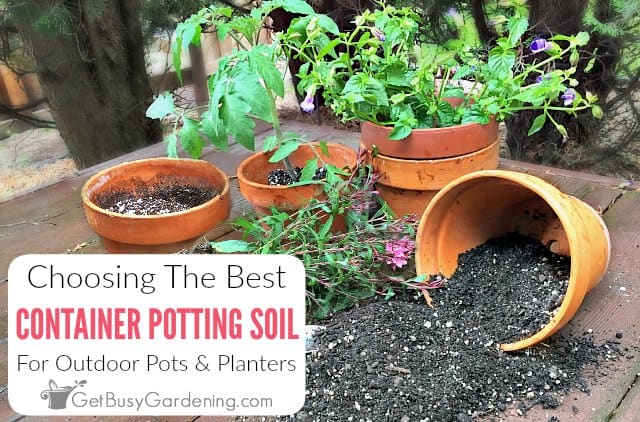
What Is The Best Soil For Container Gardening?
A good quality, all-purpose soil mix that’s specifically made for outdoor containers is usually the best option. You can make your own with my recipe below, or buy it from the store.
But if you’ve ever walked down the soil aisle at your local garden center or home improvement store, you know that there are tons of options to choose from.
So how do you know which one is best for container gardening? That’s easy, simply read the label to look for these traits:
- Light & airy – The medium should be light and fluffy, which allows for plenty of air to reach the roots.
- Well-draining – Container potting soil should always have good drainage so it doesn’t become soggy or saturated.
- Porous mix – It should also be porous, so that water and air can easily get to the roots of the plant.
- Loamy, nutrient rich – Plants need a rich, fertile soil to grow and thrive, so make sure the one you choose contains plenty of organic materials (and avoid ones with chemical fertilizers).
- Moisture retentive – Since potted plants tend to dry out faster during the summer, the mix should hold moisture.
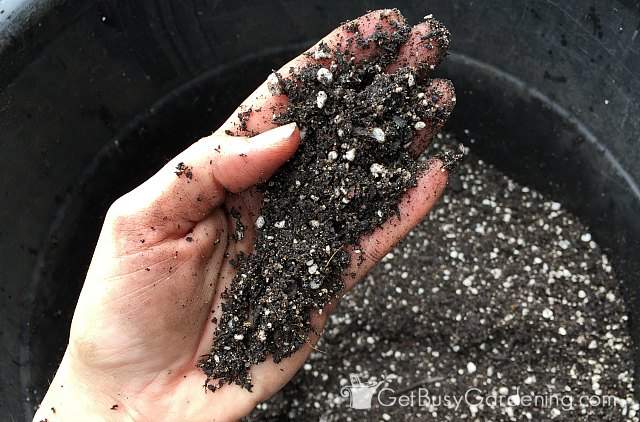
Soils & Ingredients To Avoid
I get asked all the time about using different types of soil or dirt for container gardening, and I’ve learned from experience what works and what does not. So please avoid making these common mistakes:
- Garden soil – You should never use garden soil in your pots because it is too heavy and will quickly become compacted. Plus it’s not clean, so it can contain bugs, mold spores, disease pathogens, weed seeds, and other nasty organisms.
- Topsoil or fill – I know it’s much less expensive, but do not make the mistake of using topsoil or fill dirt in your containers. These are cheaper for a reason – because they don’t have any nutrients, and they’re usually filled with rocks and dirt.
- Compost only – While you can add it to your container potting soil, using compost alone is not a good idea. It’s best to use a mix which contains other ingredients to prevent compaction, and improve aeration and drainage.
- Manure – You can mix manure into your containers, BUT only if it’s well composted. Fresh manure is too strong and can burn the roots of your plants. It can also contain pathogens that could harm your plants, or make you sick. Plus, it probably won’t smell very good.
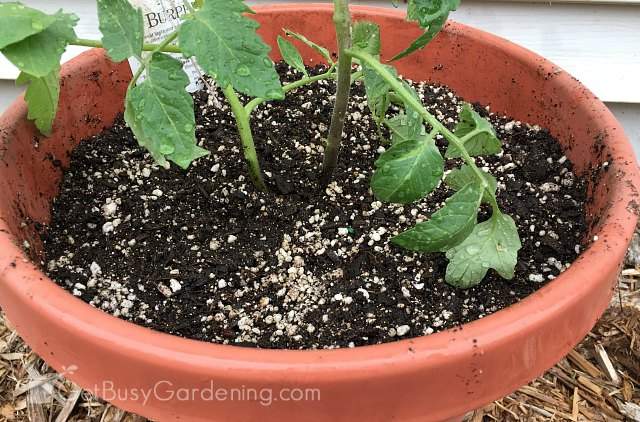
How To Make Potting Mix For Container Gardening
Below, I’ve included 2 DIY container soil recipes. The first is a general mix to use for pots that will be sitting on the ground or other sturdy surface, and the second is a soilless mix for hanging baskets and planters.
It’s amazing how heavy a pot will become once it’s filled with moist soil. So, make sure to choose the right mix for each of your containers:
1. General Container Soil Mix Recipe
This general recipe is great for using in containers that sit on the ground or on a sturdy base. Since the compost makes the soil much heavier, it’s not ideal for hanging pots.
- 2 parts peat moss, coco coir (pre-moistened), or potting soil
- 2 parts compost, composted manure, or worm castings
- 1 part perlite
- ¼-½ parts vermiculite
- 1 Tablespoon garden lime per gallon (if you use peat moss)
2. Soilless Mix Recipe
My soilless container potting mix recipe is much lighter. So it’s perfect to use in any type of hanging baskets or planter boxes.
- 2 parts peat moss or coco coir (pre-moistened)
- 1 part perlite
- ¼-½ parts vermiculite
- 1 Tablespoon garden lime per gallon (if you use peat moss)
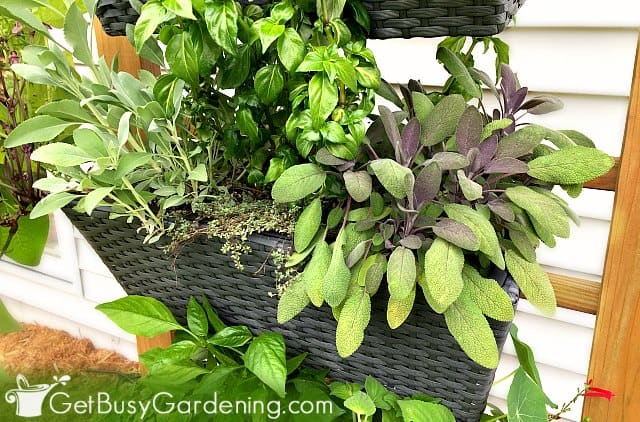
Ingredients & Substitutions
Below is a breakdown describing each ingredient and what it adds to the mix, as well as any substitutions you can make.
- Peat moss or coco coir – These two are interchangeable. They’re great for water retention and aeration. You can use a general purpose mix instead, if you have that on hand.
- Compost – This is an easy and natural way to add important nutrients and beneficial organisms into your DIY container potting soil. It also helps to retain moisture. You can substitute with well-composted manure or worm castings.
- Perlite – This is a natural ingredient that prevents soil compaction and adds aeration and drainage. You can use pumice instead if that’s easier to find where you live.
- Vermiculite – This helps the soil retain moisture, keeps the mix light and fluffy, improves drainage, and prevents compaction.
- Garden lime – You only need to add this if you’re using peat moss, because it’s acidic. So, if your plants like alkaline soil, then you’ll need to also add lime to your mix to balance out the acidity to a neutral pH level.
Step By Step Instructions
Supplies Needed:
- Measuring container (I use a 1 gallon bucket, but you can use a soil scoop, a hand trowel, or something similar)
- Shovel
- Soil scoop
- Large garden tub or wheelbarrow (for mixing)
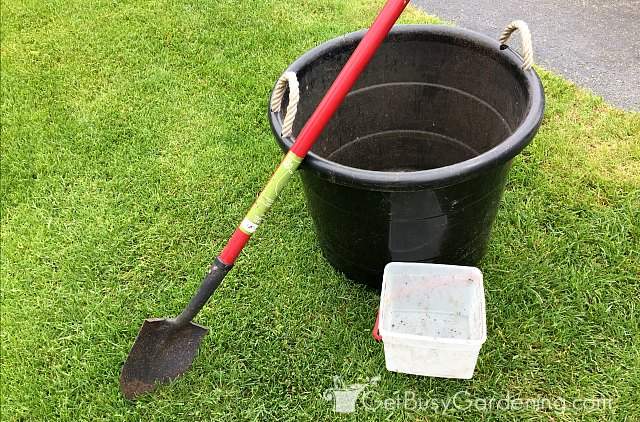
Step 1: Gather your supplies – Taking the time to gather and prepare all of your ingredients, tools, and supplies beforehand will speed things up. Make sure your mixing container (I use a large garden tub) and your shovel are both clean and dry.
Note: You can use a 1 gallon bucket, soil scoop, or a trowel to measure each part. It doesn’t matter what you use, just make sure it’s the same size for each of your ingredients.
Step 2: Measure the base ingredient(s) – If you’re making the basic container mix recipe, then add equal parts of peat moss, coco coir, OR potting soil AND the compost (don’t use potting soil or compost for the soilless mix). Pour them into your mixing container, and stir everything together until well combined.
Step 3: Add everything else – Pour the perlite, vermiculite, and garden lime (if using peat moss) into your mixing container. If your ingredients are super dry, then add a little water to moisten them.
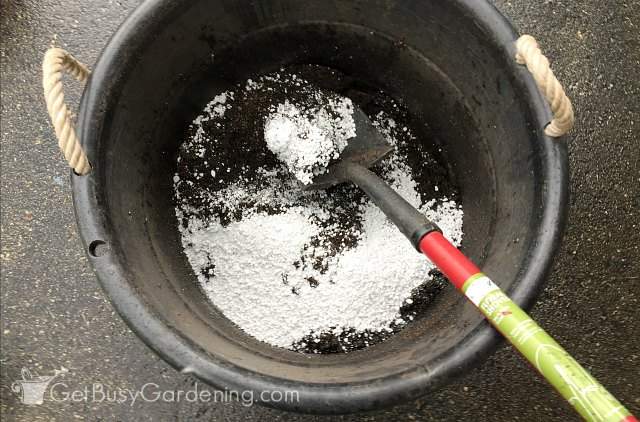
Step 4: Mix well – Stir everything together thoroughly. You want to avoid large pockets of ingredients, so make sure to mix it well during this step. If your DIY container potting soil is too dense or thick for your liking, add more perlite until it feels right.
Step 5: Use it now or store it for later – You can use it to fill your containers right away, or store it for later so you always have some on hand.
Related Post: How To Fertilize Outdoor Potted Plants & Containers
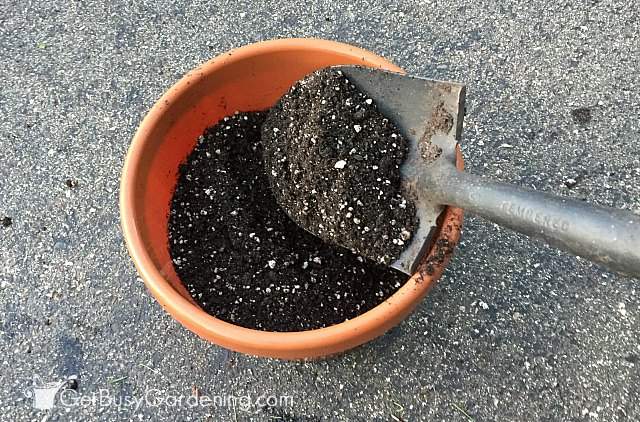
Storing Your Leftover Container Soil
To save your unused soil, simply store it in an airtight container and keep it in your garage or a shed.
I store mine in a five gallon bucket with a tight fitting lid. Whatever you use, just make sure it has an airtight lid to prevent bugs and pathogens from getting in there.
Related Post: 7 Easy DIY Potting Soil Recipes To Mix Your Own
How Often To Change The Soil In Your Containers
How often you need to replace the soil in your outdoor pots depends on what you’re growing, and the size of your container.
For annual flowers and vegetables, it’s best to start with fresh potting soil every year. This is especially important if you’ve had any issues with bugs or diseases.
If you have extremely large and deep containers, then you don’t need to replace all of the soil. In this case, I recommend refreshing the top 5-10 inches with fresh soil before you plant anything new in there.
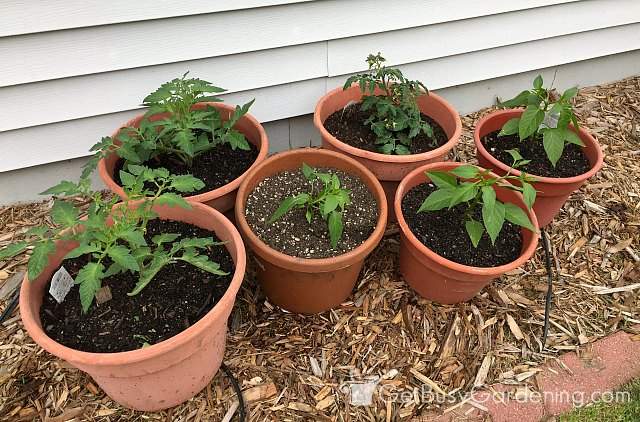
Using the best soil for containers is important to grow beautiful and healthy plants. So always check the package to find the perfect one, or make your own so you can control the ingredients.
More About Potting Soils
- How To Make Potting Soil For Indoor Plants
- How To Make Succulent Potting Soil
- How To Make Your Own Cactus Soil Mix
- How To Make DIY Seed Starting Mix
More Container Gardening Posts
- Container Gardening Design Tips & Ideas
- How To Clean Terracotta Pots (In 3 Easy Steps!)
- How To Install A DIY Drip Irrigation System For Potted Plants
Share your tips for choosing the best potting soil for container gardening or your favorite recipe in the comments section below.
Printable Step By Step Instructions
Container Garden Soil Mix Recipes

Making your own container potting soil is easy and frugal. Learn how to make it step-by-step with my 2 simple recipes.
Instructions
General Container Soil Recipe:
- 2 parts peat moss or coco coir
- 2 parts compost
- 1 part perlite
- ¼-½ parts vermiculite
- 1 Tablespoon garden lime per gallon (if you use peat moss)
Soilless Mix For Hanging Pots:
- 2 parts peat moss or coco coir
- 1 part perlite
- ¼-½ parts vermiculite
- 1 Tablespoon garden lime per gallon (if you use peat moss)
Mixing Instructions
- Gather your supplies - Before getting started, make sure your tools and your mixing container are clean and dry.
- Measure the base ingredient(s) - If you’re making the basic container soil, then measure out the peat moss OR coco coir AND the compost and pour them into your large garden tub. Then use your shovel to stir everything together until well combined. Skip this step for the soilless mix.
- Add everything else - Add the perlite, vermiculite, and garden lime (if using peat moss) into your mixing container.
- Mix well - Stir everything together thoroughly until all pockets of the ingredients are fully combined. If the mix is too dense or thick for your liking, add more perlite until it feels right.
- Use it or store it for later - You can use your DIY potting soil to fill your containers right away, or store it for later so you always have some on hand.
Notes
- Use the general soil recipe for pots that will be sitting on the ground or a sturdy surface, and the soilless mix for hanging baskets and planters.
- You can use a 1 gallon bucket, soil scoop, or a trowel to measure each part. It doesn’t matter what you use, just make sure it’s the same size for each of your ingredients.
- Store the leftovers in a bucket with a tight-fitting lid, and keep it in a cool, dry location.


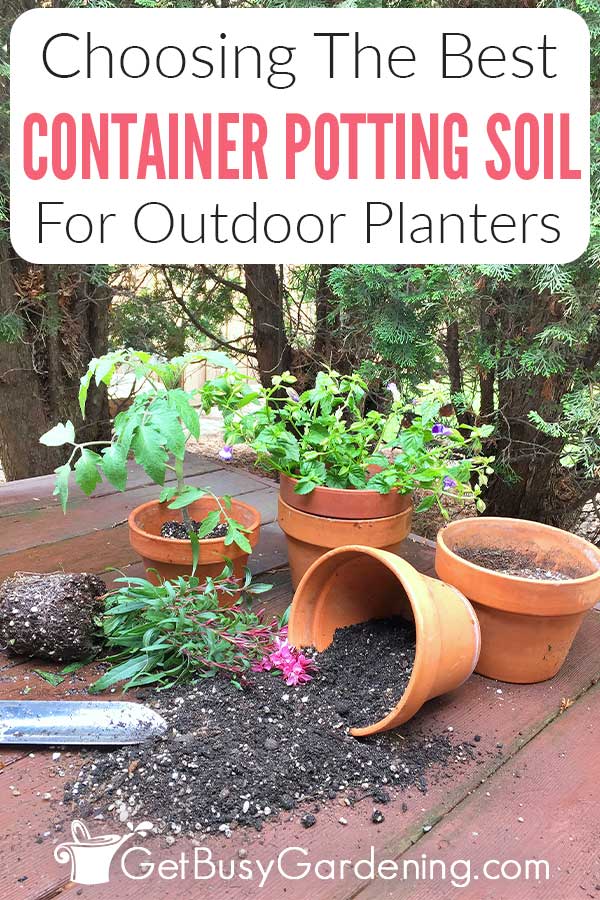
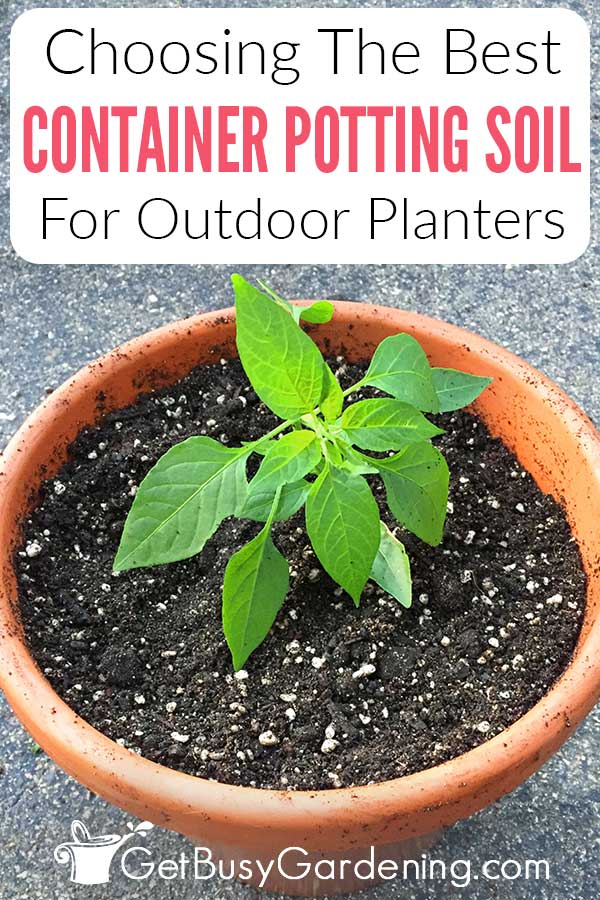
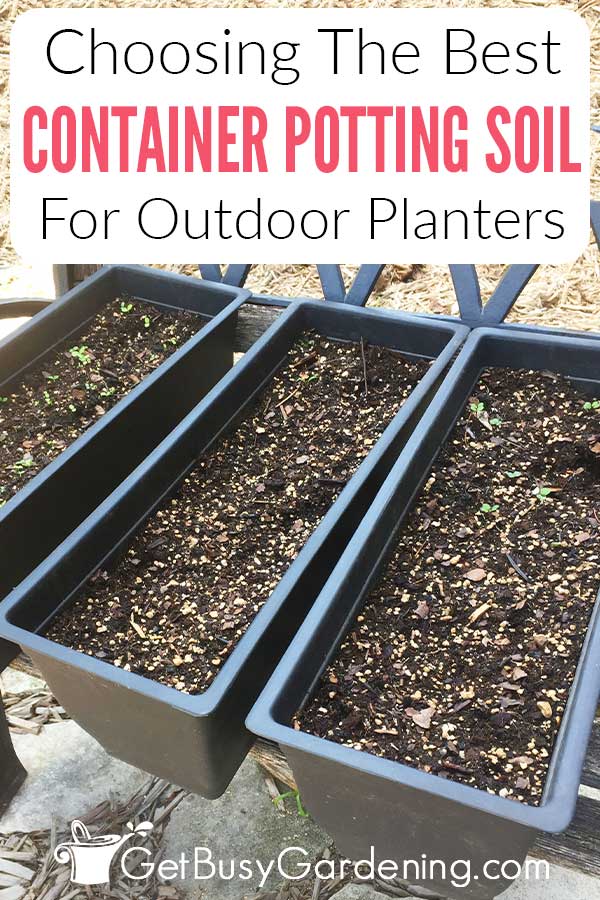



Fletcher Kohlman says
“I’ve also found that mulching helps conserve water. It’s great to see someone else promoting sustainable gardening practices!”
Frank says
Thanks for the outdoor potting soil recipes, Amy. I will be trying then out for my container growing.
Amy Andrychowicz says
You’re welcome!
Susan Vespia says
Hi. I bought Perfect Landscape container mix for container plants, but if is heavier than my bag of potting mix. Is that iproduct a true soiless medium?
Amy Andrychowicz says
Weight alone doesn’t necessarily mean the container potting mix you bought is not soilless. It could just contain more moisture than the other type you have. You won’t know for sure unless you look at the bag to see what ingredients it contains.
Enderes Cindy says
When you use container gardens, how often do you change the soil?
Amy Andrychowicz says
It depends on where you live, what you’re growing, and size your containers. In MN I grow mostly annuals or vegetables in my outdoor containers, so I change the soil every year. That’s because the roots usually fully fill the container by the end of the summer, so when I pull out the plants, all of the soil comes with them. But if your containers are very large, then you can use the same soil for many years, and just refresh the top layer every spring when you replant. On the other hand, if you live somewhere warm where your container plants grow year round, then you can just repot the plants into fresh soil as they outgrow their containers.
Laurie AL says
When storing any of your soil recipes, are you meant to leave the soil damp? They all call for moistened coir or peat moss. If so, is there any chance of mould?
Thanks for all the great advice and recipes.
Amy Andrychowicz says
I usually store my DIY potting soils when they are only slightly moist or dry. You don’t want them to be wet, or mold could definitely grow in there.
Kinga says
Hi, could you give me any recommendations for soil for rised garden bed? I am changing my soil in containers already🙂
Amy Andrychowicz says
I don’t have a recipe for raised bed potting soil, unfortunately. It depends on what you’re growing. If it’s vegetables, then you’ll want to use a high quality organic raised bed soil mix from the store. I personally start with that, and then mix in an equal amount of compost.
Kinga says
Hi, I am just a little unsure of what to do. I read in you article that using all purpose potting soil/compost mix is good for outdoor containers. But then found your recipe which ask to mix 50% potting soil with 50% compost . My first question : from what I understand you mean like mushroom compost, composted manure or homemade compost not to compost mix from shop?
Second: is it better to just use potting soil/compost mix from shop or adjust ot by adding the same amoth of compost to make your DIY recipe?
Amy Andrychowicz says
You can use any type of good quality compost for this recipe. I personally prefer to mix my own container potting soil, but you could try using a store-bought brand if you prefer. Just make sure it’s a good quality soil that’s made specifically for growing plants in containers outside.